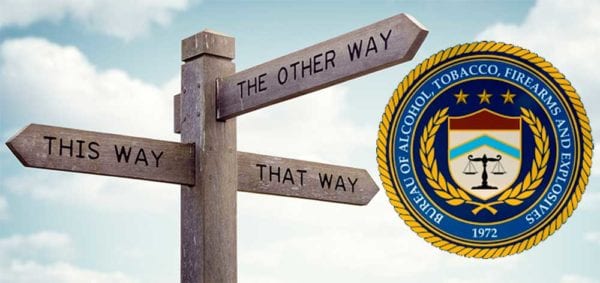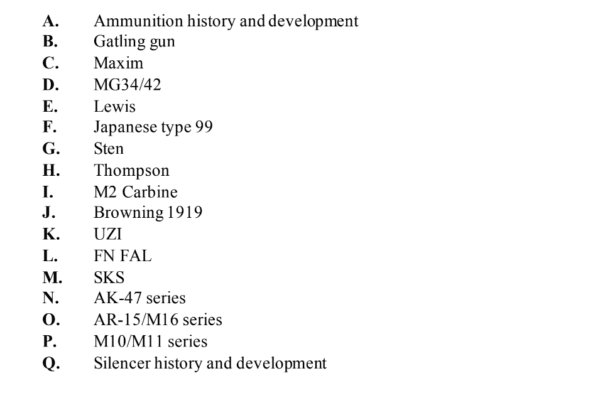
U.S.A. –-(AmmoLand.com)- For years the gun industry has wondered what training the Bureau of Alcohol, Tobacco, Firearms and Explosives (ATF) provides its employees in the Firearms and Ammunition Technology Division (FATD). Due to a Freedom of Information Act (FOIA) request filed by Gun Owners of America, we finally know.
FATD is responsible for approving firearms for the ATF. This department decides what is and isn’t a firearm.
Not only do FATD officers review samples sent in by companies in the firearms industry, but these ATF employees are used as legal experts in criminal cases. The defense can use the amount and type of training of ATF FATD officers in criminal cases. For years this training has been a secret.
When the ATF hires a new officer, the employee is assigned a mentor within FATD. The mentor is responsible for arranging on-the-job training and making sure the new employee’s activity is documented. These mentors are supposed to be “experts” in FATD.
The new officer must learn about the Gun Control Act (GCA) of 1968. The employee must know the definitions of firearms, destructive devices, shotguns, rifles, antique firearms, ammunition, armor piercing ammunition, handguns, and silencers. The officer must know the regulations centered on these items, the legal penalties for violating the GCA, and requirements for commerce in firearms. They also must understand how interstate commerce applies to law-abiding citizens and felons.
The officers are taught about different parts of the industry. They must know the differences between dealers, manufacturers, and importers. The employee must understand what each does and the laws and regulations surrounding the different parts of the industry.
FATD spends a lot of time training officers about the National Firearms Act (NFA) of 1934. The employee learns that the NFA is part of the tax code. Gun rights advocates claim that the NFA is Unconstitutional because it is a direct tax on a right. According to Murdock v. Pennsylvania, the government cannot directly tax a right.
The officer must be able to define firearms, machine guns, rifles, shotguns, any other weapons, destructive devices, and antique firearms in regards to the NFA. Many of the definitions under this section are the same as the definitions found under the GCA except for short-barreled rifles and short-barreled shotguns.
The training also goes into how dealers, manufacturers, and imports must conduct business under the NFA. This requirement means that officers must understand all ATF forms such as Form 1, 2, 3/4, 5, and 10. For example, ATF FORM 1 is for the home NFA build, and ATF Form 4 is for buying an NFA item from a dealer.
The ATF officer must also learn about the Arms Export Control Act (AECA). AECA regulates how firearms and firearms-related items are imported and exported. These regulations extend to ammunition, forgings, and castings.
The FATD employee must learn about ATF Form 5330.5. The form deals with factoring criteria for handguns. The officer must also learn about the 1989 and 1998 import studies on non-importable military rifle features. For example, many rifles are imported with modified magazine wells to prevent the use of 30-round magazines. The importer usually will convert the magwell back to be able to accept standard magazines once imported. The officer must also be aware of the 2011 Shotgun study. That study deals with what features a shotgun can have and can still be imported into the country.
The FATD officer must show that they can handle a firearm safely. They also must know how direct impingement and gas pistons work within a gun. They also must know the recoil operations of a firearm. They also must be able to explain how a simple blowback system and a delayed blowback system work. The officer must also know about marking requirements and headstamps.
An interesting thing about the training is the amount of time officers spend on machine guns which is probably the item they will hardly ever see in their job. The new employee will be assigned several machine guns from a list. The officer must evaluate, disassemble, explain the operating principle of each given gun. The officer must write a short essay about the history of the assigned firearms. The paper will be reviewed and critiqued by their peer.
The FATD employee must compare a semi-automatic firearm to an automatic firearm of the same type and show how the semi-auto gun can be converted to a machine gun. These methods include the use of lightning links, drop-in auto sears, and other ways. Glocks and UZIs are listed, and interestingly so is the M2.
Silencers is another thing officers must know about to complete the training. The agent must identify parts of a suppressor. The employee needs to learn about sound levels and know how to set up a sound meter. Suppressors fall under the NFA.
Technical examination of criminal evidence is another section of the training. This section deals with evidence handling and criminal examinations. The new FATD officer must prepare five criminal reports. Since these reports could send someone to prison for life, one would hope an agent would have to do more than just five reports.
Five seems to be the number for numerous things that the ATF has settled on for new FATD officers to complete. In addition to the criminal reports, the employee must also prepare five responses to the public and five additional import evaluations.
The FATD officer must take three armorer courses. There aren’t any specific courses listed in the FATD documents, so it seems like this is left up to the new officer. The officer must also tour a firearms manufacturing facility and an ammunition manufacturing facility. FATD considers this is enough to build a knowledge of manufacturing.
The new officer also must complete three Firearms Technology Branch assignments. The officer must also visit a courtroom and participate in a mock trial as an expert witness. The final exercise is to provide technical assistance during the execution of two search warrants.
This document has been a fantastic insight into the training of new ATF FATD officers.
About John Crump
John is a NRA instructor and a constitutional activist. John has written about firearms, interviewed people of all walks of life, and on the Constitution. John lives in Northern Virginia with his wife and sons and can be followed on Twitter at @crumpyss, or at www.crumpy.com.



Oh, so the ATF is admitting it needs an “expert” (their words) to understand the NFA? We’ve had SCotUS rulings (Chicago v. Morales) say that’s completely and totally illegal for a law to do.
How much does anyone want to bet me that almost no ATF officer can actually do this required act under section “C. Maxim”:
“evaluate, disassemble, explain the operating principle of each given gun.”
I’d bet a rather large amount against the average officer ever properly assembling the horrendously complex Maxim gun. 🙂
I’ve seen a well respected 20 years experienced gunsmith have a problem with different guns every now, so there’s not a snowballs chance an atf agent can do it.
I’m betting that the essay the article mentioned was the only test, and 1% was a passing grade… 🙂
Or it could be that it was like the Restricted Use pesticide license test I had to take 20 years ago. They had us watch a few videos, and then passed out the multiple choice test. The instructors then read the questions out loud, and then told everyone the answer to each question. Twice, to confirm that everyone had heard. And then went on to the next question. One would have to not know what an A, B, C and D is to get less than 100%. 75% was passing. Welcome to the world of federal testing… I wonder how… Read more »
Makes me feel so warm and fuzzy know that these psychopathic control freaks are out there.
How is the history of a particular firearm relevant to enforcing a tax code? Certainly no training on the Bill of Rights. I would love to see some of the essays written! LOL!